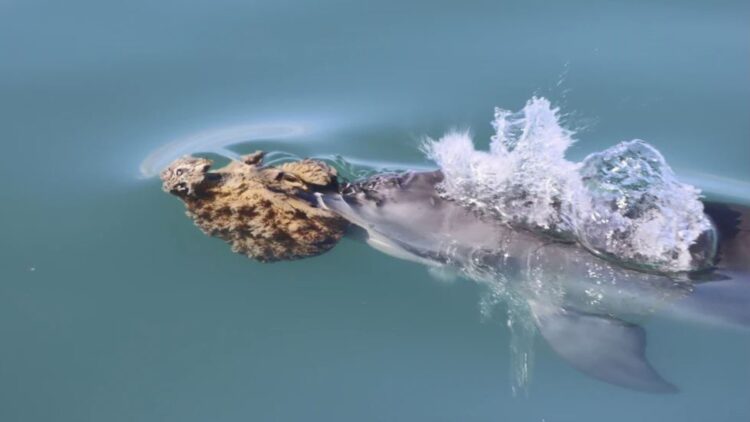The northern coasts of Australia have been the setting for a behavior referred to as the ritual of the ‘marine movie.’ Researchers from the Department of Biodiversity, Conservation and Attractions of Western Australia (DBCA) have documented how Australian humpback dolphins (Sousa sahulensis) have been seen with marine sponges on their heads while swimming around females. What seemed like an isolated incident has turned out to be a deliberate act, believed to be related to the species’ mating. ABC News reports statements from scientist Holly Raudino of the DBCA, who explains that the sponges varied in size and color, but were located in the same area of the body: on the head.
After being officially recognized in 2014, the Australian humpback dolphin has been classified as a vulnerable species by the International Union for Conservation of Nature (IUCN), as its population is small and it is threatened by pollution, habitat loss, and maritime traffic. This symbolic or mating ritual behavior first occurred in 1987 in the Puget Sound, in the United States. At that time, it was reported in a group of orcas, carrying dead salmon on their heads, a practice that spread to other groups over several weeks before disappearing. These types of events show us that these symbolic and courtship behaviors can spread among cetaceans as part of animal culture, just as they do with humans.
Australian humpback dolphins (Sousa sahulensis)
This is a species of dolphin that inhabits shallow waters between northern Australia and southern New Guinea. Its main physical characteristic is its lower dorsal fin and dark gray coloration, which distinguish it from other humpback dolphin species. It was not until 2014 that it was officially recognized as a species after three years of debate regarding its classification within the genus Sousa. With fewer than 10,000 mature individuals and a population in decline threatened by habitat loss, maritime traffic, and pollution, it has been considered vulnerable by the International Union for Conservation of Nature (IUCN).
The ‘Marine Wig’ Ritual
A group of researchers from the Department of Biodiversity, Conservation and Attractions of Western Australia (DBCA) have witnessed a most unusual behavior among a group of male humpback dolphins. The event took place off the northern coast of Australia, where images were captured of dolphins placing marine sponges on their heads. At first, it was believed to be an isolated incident, but nothing could be further from the truth: it was a mating ritual intended to court the females. What appears comedic or endearing to the human eye is actually a complex display of intelligence, creativity, and social ritual within animal culture.
According to statements to ABC News by DBCA scientist Holly Raudino, the sponges varied in shape, size, and color, but were always found in the same area of the body: the head. On the DBCA’s social media, one could find the following explanation: “These dolphins are not preparing to go to trial; their sea sponge wigs are their way of impressing the ladies, like someone offering a bouquet of flowers”.
Other similar behaviors
It is not the first time that the Stance have surprised us with this type of behavior. A group of orcas started a similar trend in the Puget Sound, in the United States, in 1987. It was then reported that a female orca was carrying dead salmon on her head. This practice, initiated by the orca nicknamed Regina George (after the character from Mean Girls), spread to other groups of orcas and lasted for several weeks before disappearing.
In addition to providing a better understanding of mating rituals among the E.T.C., this type of behavior demonstrates that the et ceo, like humans, are capable of imitating symbolic and social behaviors.
